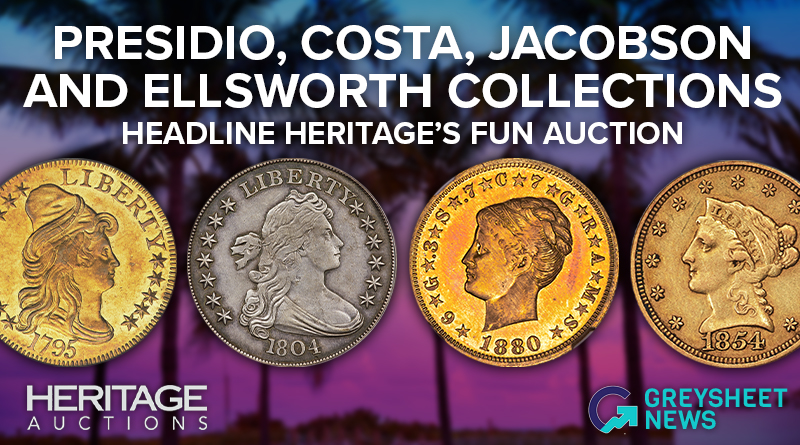Greysheet & CPG® PRICE GUIDE
- U.S. Coins /
- Pattern Coinage /
-
Patterns (1965) Values
Year
Sort by
About This Series
History and Overview
An experiment by the Bureau of the Mint to determine suitable metals to replace the 90% silver coins resulted in trial strikes of dies for dimes, quarter dollars, and half dollars. The design was the same for each denomination, and the strikes conform in size to the regular coinage. Somewhat similar to the scenario of 1942, fantasy designs were prepared with no relation to current coinage motifs, in the present instance to avoid creating “rarities” by using regular dies. The dies bear neither denominations nor any inscriptions normal for circulating coins (UNITED STATES OF AMERICA, IN GOD WE TRUST, LIBERTY) and are, in effect, tokens or medals.
Edward P. Grove and Philip Fowler, both on the engraving staff at the Philadelphia Mint, designed the obverse and reverse, respectively. The pieces were supposedly struck in the following materials:14
75% copper, 25% nickel • Cupronickel-copper (multi-layer composite) • 50% silver, 50% copper • Coin silver-copper (multi-layer composite) • Columbium, aka niobium (Type I) • Columbium, aka niobium (Type II) • Zirconium • Monel (nickel-base alloy) • Nickel, 5% silicon, with magnetic core • Stainless steel (Type 301-Type I) • Stainless steel (Type 301-Type II) • Stainless steel (Type 302).
The Mint study also considered nickel and titanium but neither of these was actually tested. No records have been located on the quantities made, whether all were made inside the Mint, and what metal varieties might exist today.
Collecting Perspective
Two sets of coins (each consisting of three dimes, three quarters, and three half dollars, encased in an acrylic block) were given to the Smithsonian Institution. No others were officially distributed, but over the years, a few have been shown in numismatic circles. Their legality has not been defined.
As it is not known which pieces might survive and in what metals, each of the three “denominations” below is assigned a Judd number based on the 12 metals in the above list. Also, the values are hypothetical, in view that for some alloys there has been no confirmation of existence.
Catalog Detail
Legal Disclaimer
The prices listed in our database are intended to be used as an indication only. Users are strongly encouraged to seek multiple sources of pricing before making a final determination of value. CDN Publishing is not responsible for typographical or database-related errors. Your use of this site indicates full acceptance of these terms.



From the Greysheet Marketplace
Buy Now: $3,695.00
Buy Now: $2,890.63
Buy Now: $120,000.00
Buy Now: $38,900.00
Buy Now: $5,500.00
Buy Now: $37,000.00
Buy Now: $3,121.88
Buy Now: $37,000.00
Buy Now: $31,500.00
Buy Now: $125,000.00
Related Stories (powered by Greysheet News)
View all news
Greysheet Catalog Details
History and Overview
An experiment by the Bureau of the Mint to determine suitable metals to replace the 90% silver coins resulted in trial strikes of dies for dimes, quarter dollars, and half dollars. The design was the same for each denomination, and the strikes conform in size to the regular coinage. Somewhat similar to the scenario of 1942, fantasy designs were prepared with no relation to current coinage motifs, in the present instance to avoid creating “rarities” by using regular dies. The dies bear neither denominations nor any inscriptions normal for circulating coins (UNITED STATES OF AMERICA, IN GOD WE TRUST, LIBERTY) and are, in effect, tokens or medals.
Edward P. Grove and Philip Fowler, both on the engraving staff at the Philadelphia Mint, designed the obverse and reverse, respectively. The pieces were supposedly struck in the following materials:14
75% copper, 25% nickel • Cupronickel-copper (multi-layer composite) • 50% silver, 50% copper • Coin silver-copper (multi-layer composite) • Columbium, aka niobium (Type I) • Columbium, aka niobium (Type II) • Zirconium • Monel (nickel-base alloy) • Nickel, 5% silicon, with magnetic core • Stainless steel (Type 301-Type I) • Stainless steel (Type 301-Type II) • Stainless steel (Type 302).
The Mint study also considered nickel and titanium but neither of these was actually tested. No records have been located on the quantities made, whether all were made inside the Mint, and what metal varieties might exist today.
Collecting Perspective
Two sets of coins (each consisting of three dimes, three quarters, and three half dollars, encased in an acrylic block) were given to the Smithsonian Institution. No others were officially distributed, but over the years, a few have been shown in numismatic circles. Their legality has not been defined.
As it is not known which pieces might survive and in what metals, each of the three “denominations” below is assigned a Judd number based on the 12 metals in the above list. Also, the values are hypothetical, in view that for some alloys there has been no confirmation of existence.
Catalog Detail
Legal Disclaimer
The prices listed in our database are intended to be used as an indication only. Users are strongly encouraged to seek multiple sources of pricing before making a final determination of value. CDN Publishing is not responsible for typographical or database-related errors. Your use of this site indicates full acceptance of these terms.










 Loading more ...
Loading more ...











